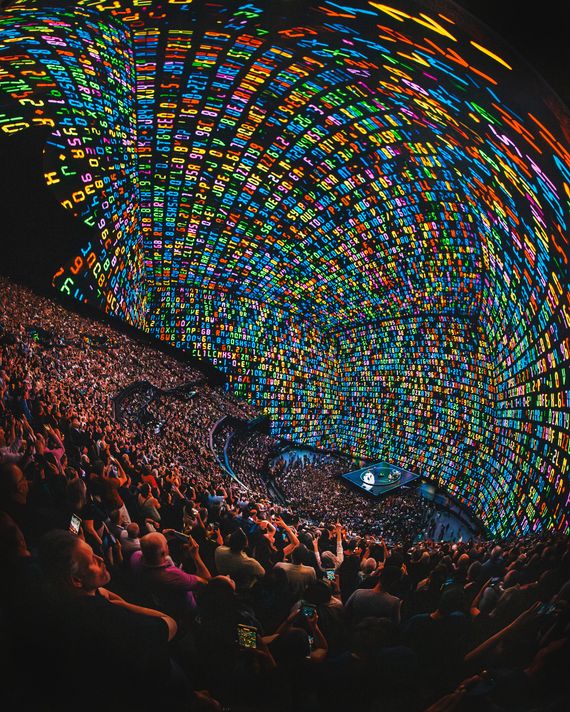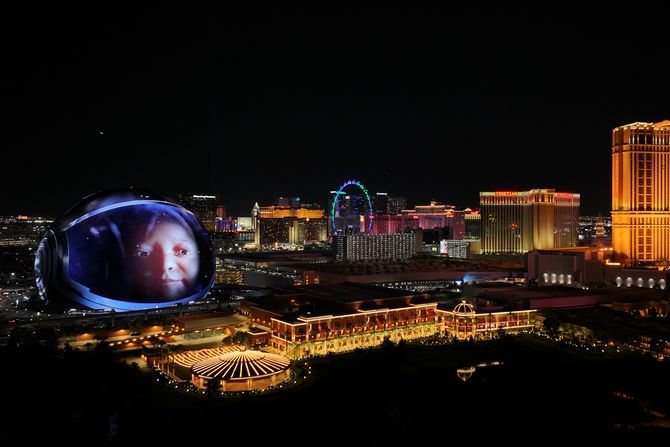
As the sun rises over a wide patch of Nevada desert, the color of the sky morphs from the deepest pink to a bright crystal blue. Bunches of shrubs and a single, singed white flag atop a tall, skinny pole become more visible as the star at the center of our solar system ascends higher and higher. It’s a breathtaking moment, one made all the more moving because it’s unfolding to the swelling opening notes of “Where the Streets Have No Name,” U2’s anthem about the vitality of human connection that has been a staple of their live shows for more than 36 years.
The thing is, technically, it’s not entirely real. That striking visual environment is an illusion created by 260 million pixels inside a massive 16K LED screen that wraps around the entire performance space within Sphere, a $2.3 billion, 366-foot-tall, 516-foot-wide rotunda adjacent to the Venetian Resort in Las Vegas. From the outside, Sphere looks like half a planet that accidentally dropped from outer space and landed less than a mile from Caesars Palace. Its exterior consists of 580,000 square feet of LED screens that project a rotating series of images — sometimes, a big emoji with expressions that range from annoyed to sleepy; a huge, semi-disturbing eyeball; or, even more disturbing, an ad for the upcoming third Trolls movie. An Uber driver describes it to me as “a masterpiece,” then adds, “It is disconcerting when you turn the corner and the moon is on the ground, though.” Yes, Sphere’s exterior can and sometimes does transform into that cratery surface.
Inside its auditorium, which fits around 20,000 people, the walls also essentially function as one huge screen, a blank, industrial, state-of-the-art canvas upon which musical artists and filmmakers can conjure seemingly any setting in their imaginations. U2 — in residency here through mid-December with U2:UV Achtung Baby Live at Sphere, a celebration of the 1991 album that pushed their sound further into the electronic realm — is getting the first crack. (Darren Aronofsky’s nature movie Postcard From Earth is slated to start screening here October 6.)
The brainchild and pet project of James Dolan, the controversial executive chairman of Madison Square Garden Sports who also owns and oversees the New York Knicks and the New York Rangers, Sphere is seeking to revolutionize the live-entertainment space and accelerate its evolution into a more digitally sophisticated experience. It’s attempting to do that at a time when many are reembracing the sense of connection that concerts provide and also expressing deep concerns about the cultural impact of the rise of AI. Will those same people pay good money to come to a macked-out orb in the middle of Sin City, a venue pitched as the equivalent of VR without the goggles? When they do, can a concert hit them in the same way with so much audiovisual stimuli to (potentially) distract?
U2’s sold-out opening-night set, which attracted numerous celebrities to the sonic snow globe including Oprah Winfrey, Paul McCartney, and Matt Damon, acted as a very public, powerful proof of Sphere’s concept, one that U2 was uniquely positioned to execute. Having danced the line between spectacle and sincerity in their live shows since the 1992–93 Zoo TV tour that U2:UV frequently and blatantly references, the rockers from Ireland understood when to crank all the digital tools at their disposal up to 11 and when to dial them back and allow the music to speak for itself.
Over the course of the night, audiences were transported into immersive, Elvis-centric cinematic installations, a Matrix-esque string of claustrophobia-inducing code, and, in a case of art imitating life that is literally right there, a seemingly live shot of the Vegas streets, something one could see IRL if they simply got up and walked out Sphere’s exit doors. Inside this supersize bubble, it’s as though all colors are sharper and all melodies more pristine, thanks to a high-tech beamforming audio system that directs the sound with exacting precision. David Haygood, a Raleigh, North Carolina, resident who attended nights one and two of U2’s show, was struck by how polished the whole place was, likening it to an art museum. “Everything was so clean,” he said. “It wasn’t antiseptic-clean. It took imagination to make it look that clean.” Haygood already has tickets to come back for two more U2 shows in December.
The performance space before the show starts looks both stunning and spare. The stage, a replica of an acrylic turntable designed by producer and frequent U2 collaborator Brian Eno, is almost diminutive within the expanse of this gray concrete palace, which transforms into someplace else — some places else? — entirely once the screens along its walls are illuminated. Bono, the loquacious front man of the group, will describe it during the concert as a cathedral, and by the end of the first show, when an art installation by Es Devlin lights up the dome with symbols of 26 Nevadan endangered species, it will actually look like one.
The sheer scale of the place, which practically insists that patrons crane their necks upward like gawking tourists, can be perceived differently depending on where one’s seats are located. For Maria Cantrell, a U2 diehard who flew in from Nashville and paid $535, including taxes and fees, for a pair of tickets on the 300-level for herself and her husband during a fan-club presale this past spring, it was a bit overwhelming. Cantrell has a fear of heights, but was hoping she would be okay if she wasn’t at the tippy-top of the seating chart. Then she got to Sphere and saw how steep the incline seemed in the higher sections, where the perspective feels more precarious due to the curvature of the dome. “I just can’t do high in certain places,” she says. After psyching herself up in the entryway for a half-hour, she tried to go to her seat, but once she got there, “I just couldn’t do it. I just ran out and then started hyperventilating.”
The staff at guest services took Cantrell to a sensory room on the same level, a space she said was designed to be calming, with white walls, beanbag chairs to sit in, and wooden children’s puzzles to play with for anyone who needs a break from overstimulation. (Cantrell says she and her husband were the only concertgoers in there at the time.) After 20 minutes and a few songs into the show, staff found seats on the 100-level for them. “Oh my God, I loved it,” she said. “I’m still so glad I came.”
Many of the people in the heavily Gen-X crowd responded to all the techy pageantry the way everyone responds to concerts in 2023: by whipping out their phones to film it. “I don’t record music at concerts,” Haygood told me. “I recorded two minutes and 33 seconds of that.” He’s referring to the Achtung Baby rollicker “Even Better Than the Real Thing,” a song accompanied by the art installation King Size, a kaleidoscopic collage of images of Vegas and clips of Elvis Presley created by artist Marco Brambilla that scrolls from the back of Sphere to its front. The movement of the video creates the optical illusion that the stage and the standing general-admission crowd around it are rising upward, a sensation unlike anything I have ever experienced. (In one video posted on YouTube, you can hear a guy in the crowd shouting incredulously, “Oh my God, we’re moving!”)
But this isn’t just eye-candy gimmickry. The King Size segment, a callback of sorts to the rolling camerawork in the music video for “Even Better Than the Real Thing,” also functions, like so much of what U2 was doing during their Achtung Baby period — where Bono routinely used a remote control onstage to channel-surf through the muck of 1990s broadcast television — as a commentary on oversaturation. “It’s exactly what some of my work is about, which is this idea of the seduction of the spectacle,” Brambilla told me prior to Sphere’s opening. “Is it going to destroy us? Is it going to make us better or worse?”
More often than not, Sphere’s spectacle effectively connected audiences to the music. During “Who’s Gonna Ride Your Wild Horses,” another Achtung Baby banger, an endless shower of electronically generated embers rained down from the top of the dome, a simulated baptism by fire that enhanced the song’s chorus. Close-ups of the band’s members — Bono, Edge, Adam Clayton, and Bram Van Den Berg, temporarily sitting in for U2 founder and drummer Larry Mullen Jr. while he recovers from surgery — frequently were projected in large scale, giving audience members the sense that each of these men was making eye contact with them. During “Love Is Blindness,” Bono encouraged the crowd to chant along with him. “One more time,” he commanded, and the audio inside Sphere was so targeted, it sounded as though he were whispering directly into your ear. (Not every flourish worked quite as effectively. For “Trying to Throw Your Arms Around the World,” a set piece involving an electronic sketch of a balloon that connected to an actual long rope was clever, but not quite grand enough for the room.)
At times, U2 dialed back on the visuals entirely; “Love Rescue Me,” which Bono dedicated to the late Jimmy Buffett, whose family was in attendance, was performed with nothing at all on those big LEDs. It was raw and lovely. U2 understood that it was best to let the music carry the moment sometimes, and during others, to give the spectacle center stage. But it never felt like the former was taking anything away from the latter.
At the end of “Where the Streets Have No Name,” after that digitally rendered sun had set and Edge’s guitar chords did their last dance, even Bono himself seemed moved by the magic of music meeting this massive state-of-the-art mini-planet for the first time. As the song ended, he put his hands over his face and appeared to do the most human thing a person can do. He cried.








